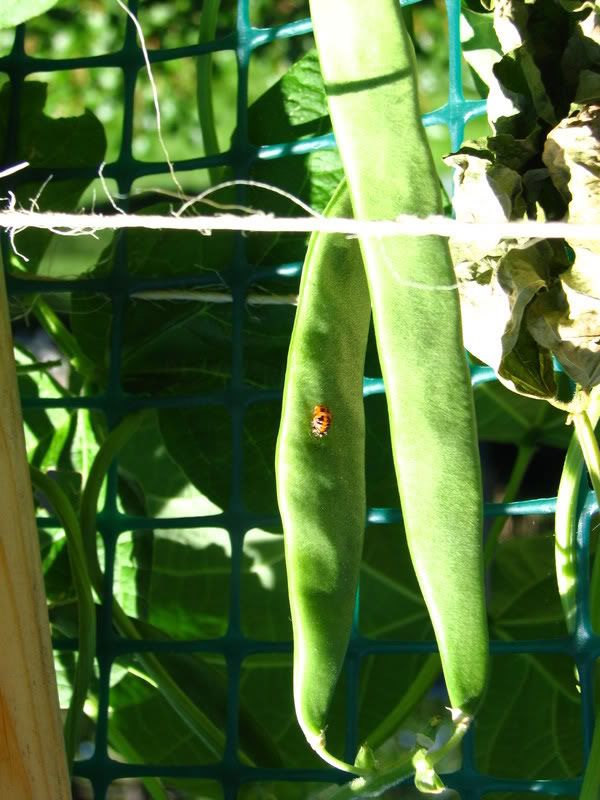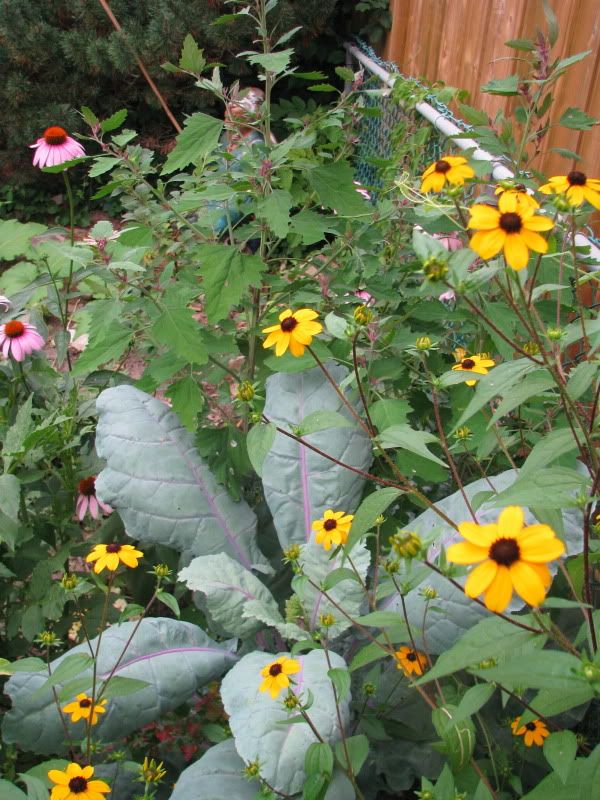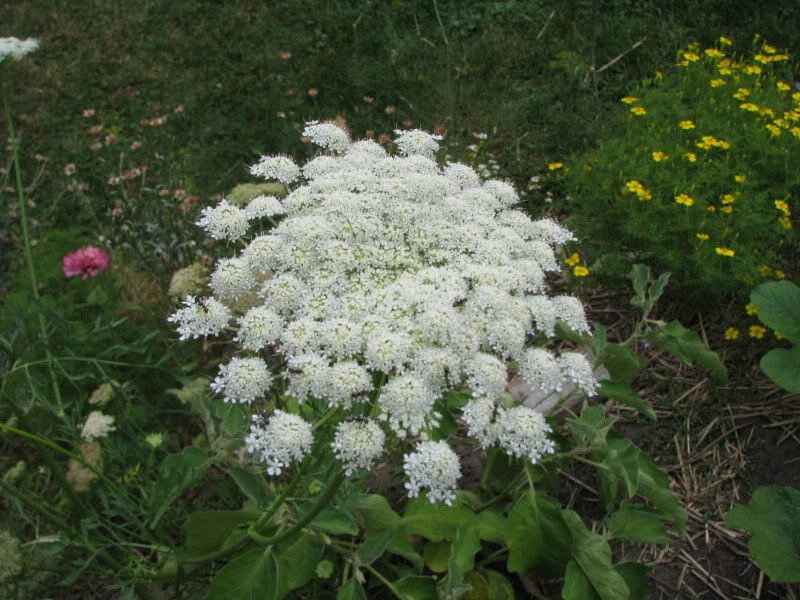For those of you that can't share in the fun of seedy days - really Daphne? Maybe you can start one - here's my take on the Eco Farm Day Bug Talk concentrating on tips for urban 'farmers.'
***

Ladybug larva on beans
When dealing with a pest bug, it is important not to just think of its favourite food plant but the whole garden. Simon Lachance from the Agricultural College of Alfred, a satellite of Guelph University spoke on how to manage the environment to control pests in a field setting but his recommendations are useful for the urban garden. In fact, we have one advantage over larger farms and that is diverse plantings – and you thought that you were at a disadvantage having to stuff all those plants into such a small space. Though Dr. Lachance was loath to make any grand proclamations, he did show a slide that showed how pest problems decreased with increasingly diverse and permanent plantings – think managed forest. As you moved toward more temporary plantings, such as rows and rows of the same annual vegetable, the opposite occurred.
Let’s take the words permanent and diverse and explore what might be happening:
Diversity is quite the buzz word, almost shorthand for a healthy habitat. Numerous creatures of every stripe form a complex web of interactions – they are eating and being eaten, helping and harming. Each plant could not exist alone and does not. The little green worm that lops around your cabbage leaf is innocent of any malevolent intent though it might aggravate the urban gardener and farmer alike, the parasitoid that injects its egg into the soft flesh appreciates its existence as do the ants that drag off its dead carcass and ultimately the next plant that grows there. The trick is not to get rid of the pests but to lower their prevalence along with the damage they cause by not making it too easy for them.
Mix up plantings within the bed.
As advocates of companion planting will tell you, some plants seem to grow better together. There are various reasons why that may be but one fascinating reason is that certain interplantings may confuse pests. Insects use sensory cues to find the delicious plants among the other ones. Perhaps they can 'smell' those butternut squash but when they get up close, they are confused by the visual cue of a giant corn stock sticking out the middle and land on it. Now it takes them longer to find their snack.

Chemical signals that attract certain pests may repel others such as the famous example of planting carrots and onions together to ward off each others pests. It also works in reverse. Certain plants may be more attractive than your precious vegetable so that the flea beetles lines up at the wild mustard rather than the broccoli. To use another example, you can then wander about picking the Colorado potato beetle off your Physalias before they notice your eggplants. In my garden, this chubby striped beetle is all over the early emerging ‘food source’ Chinese Lanterns which is why I keep this highly invasive plant in my garden. They can eat as much as they want of it and it keeps on going to produce some cut flowers in the fall.
It also helps to mix up the plants around your vegetable bed. In an agricultural setting, this may mean allowing fallow fields to grow and hedge rows to become mixed plantings of trees, shrubs and plants. This provides habitat for pest predators and parasitoids. In the urban setting, you don’t have to have what might be perceived as a messy field beside your veggies, but instead can surround them with an ornamental border. As urban yards are small, the nearby trees, foundation plantings and decorative ponds will all help to increase diversity of not only plants but habitats.
Most of us in an urban setting who are really into edibles have probably already come around to the idea that the entire yard is potential food forest anyhow, so you may already be mixing your tomatoes in with your blanket flower which brings me to the next big point.
Permanent Plantings
Not only can this mean perennials including the woody backbone, but also annuals / biennials that are allowed to flower. Many predators that feed on common garden pests require plant food such as nectar at some point in their lives. Dr. Lanchance specifically mentioned members of the carrot, aster and legume families as being beneficial to the beneficials. Before your eyes start rolling back in your head as you start redesigning your veggie patch once again, you’ll be happy to hear that you can use some of your existing plantings. Many commonly grown vegetables are part of these three families so just let them go to flower instead of pulling them up right.

Domesticated carrot in flower.
Some examples:
(Apiaceae) Carrot family: Um, carrots… also dill, caraway, fennel, parsley, coriander, parsnip and chervil that are commonly grown. Carrot, parsley and parsnip will overwinter with varying success in the north. Perennial vegetables in this family include sweet cicely and lovage.
(Astereaceae) Aster family: This includes lettuce, salsify, scorzonera, and chicory. The last two are perennial and all of these will probably self seed giving you a free crop as well as crop protection by attracting beneficials. Besides, lettuce trees – bolted lettuce – look neat.
(Fabaceae) Legume family: Peas, beans and the like. Some perennial members include apios and redbud – early flowering tree for mild regions of Canada.
A full season of bloom keeps the nectar train going all growing year. But I hardly need to encourage anyone to grow early and late flowers do I?
My new messy garden?
Yes, I am suggesting that you don’t run around the garden nipping and tucking everything into perfection. Some weeds will even help the beneficials though any competition may limit yield. I am even suggesting that after removing diseased material from the garden that you leave some of that dead matter alone allowing it to return to the soil or provide winter shelter for your wild friends. However, if you have a particular bug bugging you then you may want to look into how it hides out during the cold season and remove that particular habitat from vulnerable areas. This may include taking out host plants or mulch. I hesitate to write this as mulch almost always provides more benefits than otherwise.
For most of us we are dealing with a diversity of edibles in a small area with a diversity of pests and beneficials to such an extend that it is impossible to do the natural math so allowing more rather than less is almost certainly the best strategy.
Long live diversity.
Links
Wildlife Fletcher Garden has lots of great articles for increasing diversity and attracting wildlife in your garden
Pollination Canada, a Seeds of Diversity initiative to look at this important class of beneficials.
Companion Planting page by Ecological Agriculture Projects, McGill University

6 comments:
This is one great post! I’m just trying to apply in my garden most of what you have mentioned here.
I’m already growing carrots and onions together. And this year, Im planning to mix up some veggies and flowers so I would get these positive effects you are talking about.
And I don’t think that it will look messy, it can only look very colorful!
What a cool blog, I am so happy you stopped over at mine so that I could discover yours!
As to seeds, well I do have way too many of them. I might not have a seedy Saturday, but I do have some blogger friends that like to share. This year I ended up with way too much.
I like to mix up my plantings a bit too, but with the caveat that I also rotate so I don't mix them up too much. I do let my cilantro/coriander, dill, and parsley self sow every year. They end up in the weirdest spots sometimes, but they really do attract the best of the beneficials. Lacewings love my dill. The cilantro flowers attract all kinds of bees and predatory wasps. I didn't see any insects (including bees) on my lettuce flowers. They all seemed to leave that one alone. Across my four foot wide beds I put peppers to the south, then carrots, then tomatoes then marigolds in the back between every second tomato plant. It works amazingly well. They are still in rows down the long way (to get as many tomatoes in as possible). On the ends of the beds I plant basil and borage. So I do a lot of interplanting, but still stick to rows with this bed.
Thank you again, Can you tell me where can I find a list of vegetable that they help each other, like carrot v.s. Onion and etc...?
I will try to make it to the seed Fest. next year, hopefully, I am still learning to do gardening
I found the link for the Companion Planting Chat, very useful.
http://attra.ncat.org/new_pubs/attra-pub/complant.html?id=other#chart
Look up 'polyculture,' 'companion planting,' and 'guild planting' to get some ideas.
There is also a commonly available book called Carrots love Tomatoes with lots of suggestions.
Post a Comment